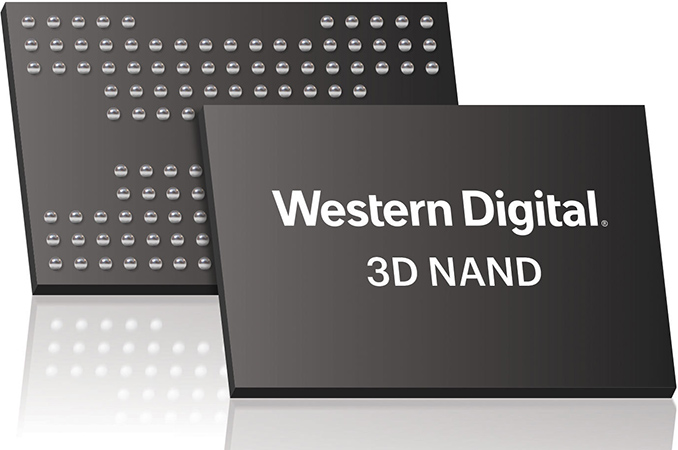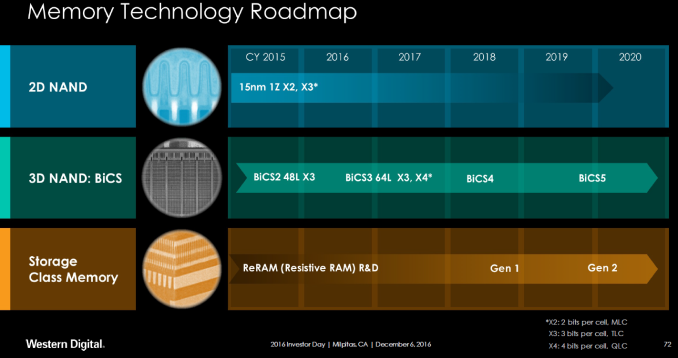Western Digital Begins to Sample QLC BiCS4: 1.33 Tbit 96-Layer 3D NAND
by Anton Shilov on July 20, 2018 2:00 PM EST
Western Digital has started sampling its 96-layer 3D NAND chips featuring QLC architecture that stores four bits per cell. The chip happens to be the world’s highest-capacity 3D NAND device. The company expects to commence volume shipments of this memory chip already this calendar year.
Western Digital’s 96-layer BICS4 3D QLC NAND chip can store up to 1.33 Tb of raw data, or around 166 GB. The IC will be initially used for consumer products Western Digital sells under the SanDisk brand, so think of memory cards (e.g., high-capacity SD and microSD products), USB drives, and some other devices. The manufacturer expects its 3D QLD NAND memory to be used in a variety of applications, including retail, mobile, embedded, client, and enterprise, but does not elaborate on timing at this point.
The 1.33-Tb BICS4 IC is Western Digital’s second-gen 3D QLC NAND device. Last year the company announced its BICS3 64-layer 3D QLC chips featuring a 768 Gb capacity, but it is unclear whether they have ever been used for commercial products. Meanwhile, it is clear that the device was used to learn about 3D QLC behavior in general (i.e., endurance, read errors, retention, etc.)
Western Digital and its manufacturing partner Toshiba started volume production of 96-layer 3D NAND earlier this year. Western Digital confirmed in late May that it had begun volume shipments of its BiCS4 memory to its retail customers, which most probably means that the new 96-layer 3D NAND ICs were used for select SanDisk-branded products. The first BiCS4 products that Western Digital announced were 256 Gb 3D TLC ICs, so it is highly likely that they have been in mass production for some time now.
As it appears, yields of 96-layer 3D NAND have been good enoug,h and things that the company has learned with BiCS3 QLC were substantial, so Western Digital moved right to its top-of-the-range capacity of 1.33 Tb per chip. What is noteworthy is that officially the BiCS4 range was to include both TLC and QLC ICs with capacities ranging from 256 Gb to 1 Tb, so the 1.33 Tb IC is a surprising addition to the lineup which signals Western Digital’s confidence of its technology.
Related Reading
- Western Digital Announce BiCS4 3D NAND: 96 Layers, TLC & QLC, Up to 1 Tb per Chip
- Western Digital: 96-Layer 3D NAND Progressing Well, Shipping to Retail Customers
- Western Digital Announces Four Bit Per Cell 64-Layer 3D NAND Flash
- Intel Teases Upcoming QLC SSD For Datacenters
- Samsung Begins Mass Production Of 96L 3D NAND
- We Found a Prototype 4 TB Intel QLC SSD
- Intel QLC NAND Updates: Up to 20TB In 2.5-inch SSD
- Intel And Micron Launch First QLC NAND: Micron 5210 ION Enterprise SATA SSD
Source: Western Digital











40 Comments
View All Comments
Tyns - Saturday, July 21, 2018 - link
How many drive writes per day does the Seagate IronWolf 12TB workload rating rate it?.04 DWPD
This complaining opabout endurance is poppycock from people who are clueless. Buy optane drives of you need to a full drive write ever two hours.
CheapSushi - Saturday, July 21, 2018 - link
exactly, please they're acting as if they have SLC drives themselves. LOL sure.PeachNCream - Saturday, July 21, 2018 - link
If you feel so secure about QLC, why bother to raise such a stink and further quote an as-yet unproven endurance rating (1000 P/E cycles - when 500 is the current capability of existing QLC products for sale today)? It's clear you aren't entirely secure in your opinion and feel the need to lash out at others to address your insecurities. I mean you're also the same person that didn't know in 2018 that Killer announced a switch to Intel NICs in 2016.BillBear - Monday, July 23, 2018 - link
Isn't it true that one of the things that happened when they moved to 3D flash was that they also moved to an older, larger process node that had better endurance, and that adding more layers made up for the fact that each individual component in the layers of the chip were larger?That was my understanding of what would happen when 3D Flash was still theoretical.
Did something change since then?
watzupken - Saturday, July 21, 2018 - link
QLC is probably going to be great for those that are using their SSD for storage/ backup purpose. No matter what the manufacturers claim, QLC's endurance is going to be poor. It is typical marketing to downplay flaws. It will only be interesting if the price is right.Death666Angel - Saturday, July 21, 2018 - link
"It will only be interesting if the price is right." is true of everything.Tyns - Saturday, July 21, 2018 - link
96L QLC doubles the bit density of 64L TLC, so prices should halve.Also note that BiCS3 bit density at 72L is equal to IMFT NAND at 64L, so BiCS is way behind for equal layers with IMFT.
Oxford Guy - Saturday, July 21, 2018 - link
Should and will are two different things. The price of the Calyos case has more than doubled.Cliff34 - Thursday, July 26, 2018 - link
The market price is never determined solely on manufacturing cost.Luckz - Monday, July 23, 2018 - link
From what I gathered SSDs don't get along so well with being a written to, then powered off for a long time style backup device.Not sure if QLC has equal or worse issues in that use case.